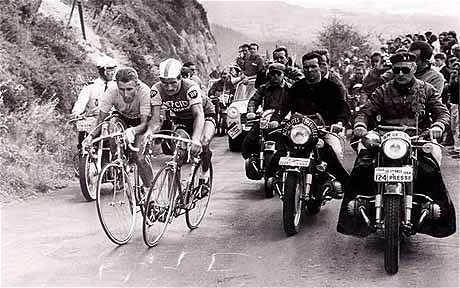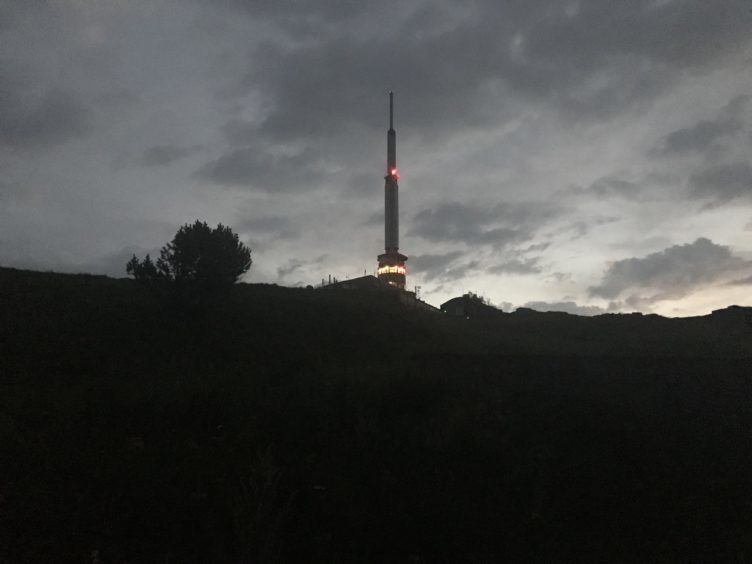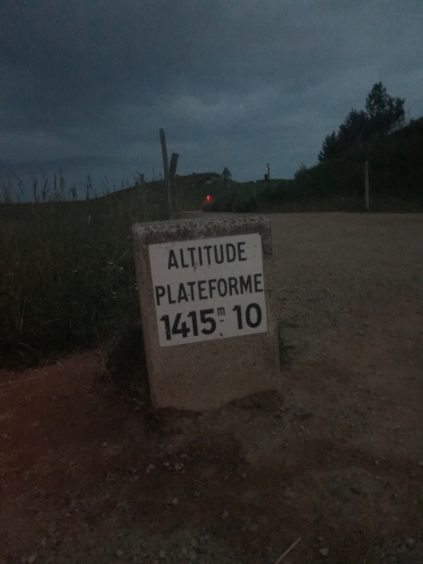The cyclist, Raphaël Géminiani, said in 2013: “If the photo had not been taken then the legend would never have existed.”
The image in question is one encapsulating an epic duel in the Tour de France on July 10 1964 and it has captured my imagination since I was a teenager. It captures a precise moment in time where Jacques Anquetil, wearing the Yellow Jersey of race leader and his arch rival, Raymond Poulidor, are riding shoulder to shoulder.
Neither rider in the photo is yielding, and they are locked together, fighting for what was not just the stage win, but what would be the outcome of the 51st Tour de France (TdF). Around them, official race motorbikes and an estimated 500,000 spectators are witnessing a battle royale on the slopes of the extinct volcano of the Puy de Dome.
Set in the Auvergne region of France, near Clermont-Ferrand, the volcano stands alone, towering above the surrounding countryside. Sadly, the road that set the scene for Poulidor’s and Anquetil’s epic battle has been closed to all traffic, including bicycles, for many years.
Instead, a railway ferries the tourists up to the summit and the warning signs on the barrier at the foot of the last 5km state that no traffic can go beyond this point. Apparently, the reason is to keep the road clear for emergency vehicles, should there be such a need.
My own obsession with the Puy de Dome began when I first saw that black and white image, but with the road closed to all, the chance of cycling up seemed highly unlikely.
Then, last week, I was working in Issoire, 30km from the Puy de Dome, and a small seed entered into my thoughts that quickly grew into a fully formed plan to ride up to the summit. I had looked through various reports and it seemed that before sunrise when the railway wasn’t operating the authorities seemed to tolerate nocturnal two-wheeled excursions.
So it was with much excitement and a certain amount of trepidation I set my alarm for 3.30 am. I was in my van for 4am driving to Clermont-Ferrand and by 4.30am I was climbing up the initial slopes of the volcano from Royat. I soon reached the barrier blocking the road and ducked under it to ascend the last 5km that cork-screwed around the summit. Looking up, the red light on the mast showed the top which seemed impossibly steep above me. Immediately the slope grew steeper and the average gradient of 12% continued to the top. It felt tough as I pushed the pedals around and rolled up the smooth tarmac with a sense of urgency.
I needed to be back in Issoire to start work at 7am, so I had calculated my latest arrival time at the summit could be 6am. As the hour struck I still had 1km to go, and I was determined I was going to make it to the top. It seemed pointless quitting when I had put in so much effort to get here and I was so close. I reached the summit for 6:06am, took a couple of quick photographs and then descended back quickly to the van. I was soon back on the road and just made it back to my hotel on time, ready to meet clients for breakfast.
I had been nervous the climb wouldn’t live up to my expectations, but even in the dark the experience exceeded anything I could have expected and I spent the rest of the day guiding cyclists with a big grin on my face. Oh and if you are wondering, Raymond Poulidor broke free and won the stage, 42 seconds ahead of Anquetil. It wasn’t enough. Anquetil still had 14 seconds in hand and held onto the race lead, which he extended to 55 seconds in the final time-trial.
Join the Blazing Saddles Strava Club at: www.strava.com/clubs/BlazingSaddlesWeekendCourier












